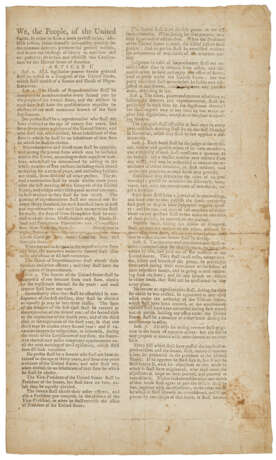ID 1119174
Lot 119 | The first separate printing of the Constituion in Connecticut
Estimate value
$ 100 000 – 150 000
New Haven, c. 26 September 1787
UNITED STATES CONSTITUTION – We, the People, of the United States, in order to form a more perfect union…. [New Haven: Printed by Thomas and Samuel Green, on or after 26 September 1787].
The first separate printing of the Constitution in Connecticut—the only copy extant. A superb, extremely rare contemporary printing of the Constitution, printed by Thomas and Samuel Green of New Haven, publishers of the Connecticut Journal, who enjoy the distinction of issuing the first printing of the Constitution in the state in the pages of their newspaper on 26 September 1787—eight days after it first appeared in print on Dunlap's press in Philadelphia (Rapport, 85). Like other printers who reprinted the text of the proposed constitution in their papers, the Greens were loath not to waste the effort of setting approximately 5,000 words of text into type, and issued this separate edition. A close examination of the version in the Connecticut Journal version and the present copy confirm they both come from the same typeset.
Unlike most separate contemporary printings of the Constitution, there is no title before the preamble, nor does it include Washington's endorsement or the Convention's resolution to send the document for the states for ratification—a circumstance that would suggest that this copy was designed for consultation by potential delegates to the Connecticut ratification convention. Whether this copy was sanctioned officially or a private project of the printer is unknown, but it appears to have been first held by Elizur Goodrich (1761-1849), a prominent New Haven Attorney who later represented Connecticut in the House of Representatives (1799-1803). After receiving the copy, Goodrich, writing on the blank portion of the fourth page, directed a "Mrs. Shulman" to send it "immediately" to his father, the Rev. Elizur Goodrich in Durham, adding the heading "Federal Convention" above the addressee's name. (Above his heading, the younger Goodrich appears to have written "Federal Extra"—possibly a nod to the fact that this version was printed by the Connecticut Journal and could be characterized loosely as an "Extra," and a strong indication of the political bent of the printers.) However, neither the elder or younger Goodrich attended the convention at Hartford. The younger Goodrich likely sent this to his father as the elder Goodrich was an influential figure in Durham, Connecticut and would have been an effective advocate. But if that was the case, Goodrich's words fell on deaf ears. On 12 November, a special town meeting voted 67 to 4 to reject the proposed constitution and sent James Wadsworth and Daniel Hall, both of whom dutifully voted "no" on 9 January 1788. See "Proceedings of the Connecticut Convention," Collier's Weekly Monitor, Litchfield, Conn., 14 January 1788, pp. 2-3.
Extremely rare. RBH records no other copies appearing at auction. Not recorded in Evans, Bristol or Ford. See Leonard Rapport, "Printed the Constitution: The Convention and newspaper Imprints, August-November 1787," Prologue, v. 2 (Fall 1970) p. 85.
Four pages, bifolium, 307 x 188mm, printed in two columns, addressed in manuscript on blank portion of second page to the Rev. Elizur Goodrich D.D. in Durham, Connecticut. (Horizontal fold separation neatly repaired, marginal losses infilled, light soiling). Provenance: Elizur Goodrich, 1761-1849, transmitted to: – Rev. Elizur Goodrich, 1734-1797 (manuscript transmittal) – Howard B. Field, Jr. (his sale, Sotheby's New York, 13 December 2000, lot 207, without printing attribution and Goodrich presumed a delegate to the Connecticut ratification convention).
| Category: | Book and magazine graphics |
|---|
| Category: | Book and magazine graphics |
|---|
| Address of auction |
CHRISTIE'S 20 Rockefeller Plaza 10020 New York USA | ||||||||||||||
|---|---|---|---|---|---|---|---|---|---|---|---|---|---|---|---|
| Preview |
| ||||||||||||||
| Phone | +1 212 636 2000 | ||||||||||||||
| Fax | +1 212 636 4930 | ||||||||||||||
| Conditions of purchase | Conditions of purchase | ||||||||||||||
| Shipping |
Postal service Courier service pickup by yourself | ||||||||||||||
| Payment methods |
Wire Transfer | ||||||||||||||
| Business hours | Business hours
|





